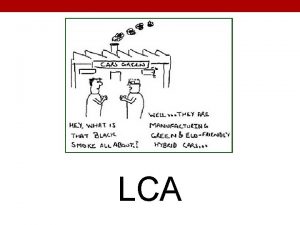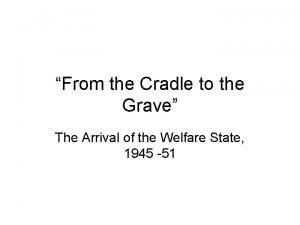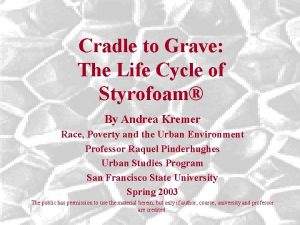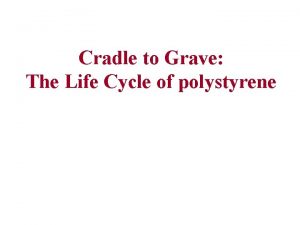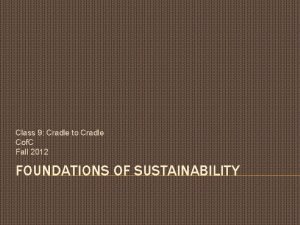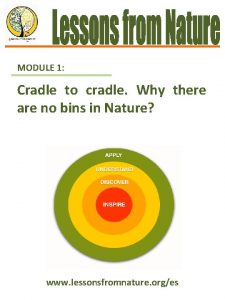From cradle to grave The rock physics life













- Slides: 13

«From cradle to grave» The rock physics «life story» of a clastic sediment (…and how it controls AVO signatures) Prof. Per Avseth, NTNU/G&G Resources ROSE Meeting, 24/4 -2017

Rock physics properties and geological processes A brief «life story» of a clastic sediment

Present day reservoir and seismic properties are controlled by burial history Age (M. yrs) 200 0 100 B Burial depth/Temp. Tectonic uplift Mechanical compaction A B Deposition Sorting variability 70 o. C Chemical compaction 0. 4 Por. 0 A Vp/Vs Qz cement volume = integral over time and temp. Mechanical compaction B B Sorting variability Age (M. yrs) A Chemical compaction HC trends A Acoustic Impedance

Combined modeling of burial history and rock physics Mechanical compaction (Lander and Walderhaug, 1999) Stable packing configuration Initial volume of pore filling material Effective stress Sum of pore space: Dep. porosity Exponential decline factor Chemical compaction (Walderhaug, 1996), when T > 70 C Volume of Qz cement precipitated between time T 1 and T 2 Molar weight of qz Qz- precipitation rate Qz- surface area Porosity at Cement start Volume of Qz cement at time Qz- density T 1 Rock physics modeling Hertz-Mindlin (mech. comp) Dvorkin-Nur + Hashin-Shtrikman (chemical compaction) 4 Heat rate

Combined modeling of burial history and rock physics A brief «life story» of a clastic sediment

S l i d e 6 Rock physics and AVO modeling constrained by burial history 2. Diagenetic modeling (Walderhaug) 1. Burial history 250 0 Cement volume Geologic Age (M. Yr) Deposition Porosity Stø Fm (Present day burial) Onset cement Max. burial Burial depth (m) Temperature (degrees C) Depth/Temperature 3. Rock physics modeling (Dvorkin-Nur) Acoustic Imp. Brine Oil Vp/Vs Oil Brine 4. AVO modeling (Zoeppritz) Reflectivity 0. 5 + shale compaction and RP 0 -0. 5 Depth/Temperature Angle of indicence

RPT and AVO analysis @Pingvin well 7319/12 -1 (Seismic data from MCG) Vp/Vs shale Brine sand Gas AI heterolithics Porosity/Rock stiffness Limestone Gas (tight) Fluid trend AI Gradient Litho/Fluid classification Intercept Vp/Vs

Burial analysis and simulated AVO signatures in Pingvin (7319/12 -1) Gas Uplift = 700 m 700 Brine sand Oil Cem. sst Unc. sand Sorting Gas Diag. Brine Shale Max burial = 1250 m Onset cementation = 70 C Net erosion map from N. Johansen (2017) Oil Cap-rock Reservoir Gas Oil Brine The reservoir sands in Pingvin has not been buried deep enough to be cemented! Hence, great fluid sensitivity! AVO class III expected for any HC-fill.

Comparing simulated AVO for Pingvin and more uplifted Jura reservoir (Soft vs. stiff response: AVO III AVO IIp)

1 0 Example: Wisting Central: 7324/8 -1; Uplift=1500 m Sea Shale trend Brine sst trend Mech. compaction Chemical compaction Burial history Qz cem. AVO Brine Oil Zoom in: Fuglen Fm Qz cement observed in Stø Fm

1 1 Summary: How burial controls AVO and fluid sensitivity Age AVO class III Pingvin 70 o. C depth Eocene case (unc) Eocene case (cem) AVO class III-IV AVO class II-III AVO class II-IIp Jura structure

Conclusions 12 • Geologial processes and burial history control fluid sensitivity and AVO signatures of sandstone reservoirs. • Reservoir sands that have not been buried deep enough to experience chemical compaction (cementation), will have large fluid sensitivity and normally class III-IV AVO (bright spots). • Reservoir sandstones that have been buried below 70 C for a significant period of time, will have relatively low fluid sensitivity and normally AVO class I-II (dim-spots). • Most hydrocarbon filled reservoirs should be expected to be cemented, hence with low seismic fluid sensitivity and AVO class I to II.

The future is dim…. . (? )
 Cradle to grave cradle to gate
Cradle to grave cradle to gate Sustainability & resource productivity consulting
Sustainability & resource productivity consulting Bedankt
Bedankt Cradle to cradle
Cradle to cradle Igneous rock sedimentary rock metamorphic rock
Igneous rock sedimentary rock metamorphic rock Cradle to grave
Cradle to grave Compact city
Compact city Cradle to grave
Cradle to grave Rock cycle
Rock cycle Compaction and cementation
Compaction and cementation Rock climb
Rock climb A rock climber's shoe loosens a rock and her climbing buddy
A rock climber's shoe loosens a rock and her climbing buddy Chapter 3 standardized test practice answers
Chapter 3 standardized test practice answers Rock cycle of sedimentary rocks
Rock cycle of sedimentary rocks
